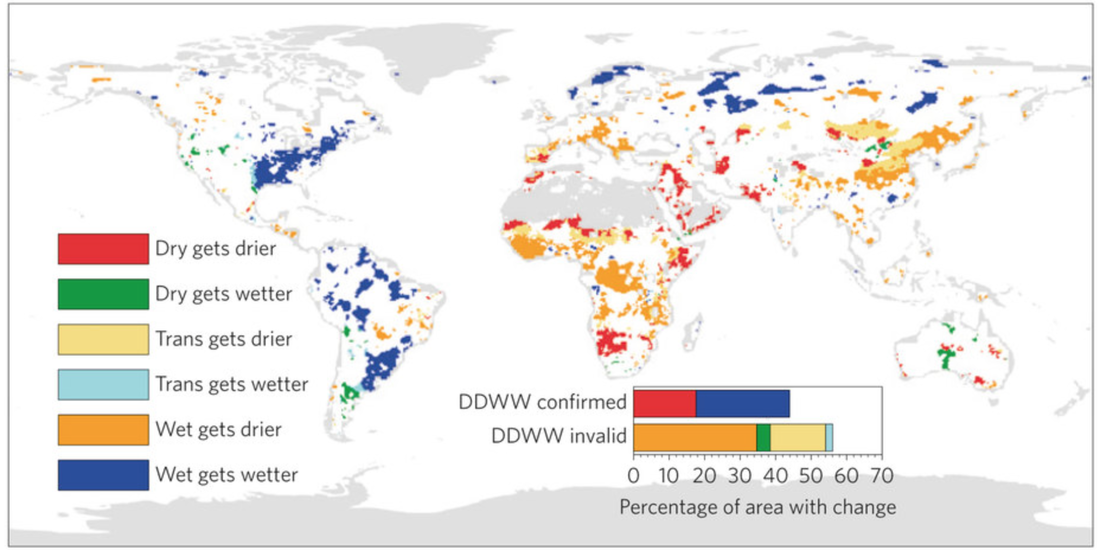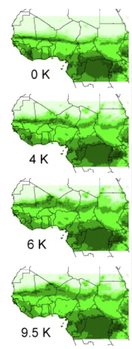|
As humans we've been engaged in unplanned terraforming for many years, as I discussed in a post a few months ago. This has come in the form of direct changes to the land via agriculture, logging, and urbanization, and (more recently) indirect changes via greenhouse-gas emissions. The direct changes are more localized and intense, while the latter are generally regional-to-global and comparatively modest. Within each category of change, there are a range of mechanisms at play, from albedo feedback to land-atmosphere interaction effects (on soil moisture, dust, etc). Inspired by a thoughtful piece from a few weeks ago, here I'll focus in particular on desertification -- this focus also helping to set some reasonable parameters on the scope of a single post. One of the core problems with desertification is the phenomenon known as "dry get drier, wet get wetter", which is at its heart a consequence of a strengthening of the water cycle in a warmer climate. This concept, while well-supported theoretically, applies to observations only in certain areas of the globe (see figure below). However, it's also worth noting that much of this non-application depends on the exact definitions of 'wet' and 'dry' used: for example, the relatively dry subtropics, like the Mediterranean, are indeed expected to dry further as this century goes on, but are considered 'wet' by that paper's reckoning.  Observed trends in precipitation from the mid- to late 20th century, combined with climatological moistness/dryness information to categorize regions according to whether they obey the 'dry get drier, wet get wetter' paradigm. From Greve et al. 2014, "Global assessment of trends in wetting and drying over land." If we know deserts are encroaching, on farmland and cities alike, what can we do about it? In a sense, the forces enabling us to "turn back the deserts" are the same as those that we leveraged to cause the changes in the first place, and they are familiarly modern: enormous sums of money, massive spatial coordination, and skillful biophysical and climate models that allow for an understanding of how to optimize resources (e.g. the most-strategic locations to plant trees or to construct irrigation systems). Many of the modifications of course involve the areas surrounding cities, which are much larger and often easier to change, as implementing a different tilling method or planting more trees involves relatively few people and little cost compared to dealing with thousands or millions of individual units in an urban area. Perhaps the best-known example of what could be considered purposeful terraforming is the remarkably successful shift in agricultural practices in the US High Plains in the mid-20th century. Following suspicions that human mistakes were to blame for the severity of the Dust Bowl (later proved correct), agricultural-extension efforts spread the gospel of practices like not leaving freshly tilled soil exposed to the wind. These changes were tested in the 1950s drought, which based on the SST pattern alone would have been equally bad or worse than the 1930s, and the result: no sad families leaving Oklahoma in beat-up cars. Mission accomplished.
While primarily affecting rural residents, cities are of significant interest in the desertification problem because a. they are centers of people and resources, which suffer the most in absolute numbers when dust chokes lungs or shuts down businesses, and b. they are inextricably connected to the surrounding landscape. As a neat illustration of the latter point, a study in Iran directly connected urbanization to desertification through the greater wealth of urban residents, and their correspondingly greater usage and therefore wastage of water. Cities are also in some sense useful laboratories for studying aspects of desertification in microcosm, given that they nearly always have higher temperatures and lower moisture than neighboring areas -- due in part to the urban-heat-island effect and in part to the lack of permeable surfaces wherein moisture can be retained.
Finally, thinking abstractly, cities are instructive in a way because they represent the most complex systems we as a species have ever constructed, and their elaborate infrastructure and balancing of many interests perhaps can provide a sort of framework for how to go about tweaking the analogously (but much more) complex climate system. These viewpoint has even made it up to the stodgy folks at the United Nations Environment Programme. While I believe the overall situation is serious, it merits optimism. That being said, far-fetched plans such as towing icebergs to the Persian Gulf, or building mountains there to squeeze out moisture, will never happen in the foreseeable future – even gushers of oil money just aren't enough to be able to terraform on those kinds of scales with anything like current technology. Besides, shifting cartography is a matter not just of physical geography, but of social and geopolitical geography, and this truism has inspired some very specific meditations on what it all means. A more-realistic prediction would be that in desertifying regions, cities themselves will change to match their surroundings and remain sustainable -- as one small example, constructing buildings from naturally occurring (and naturally insulating) sand. Regardless, industrialization, deforestation, and urbanization will continue apace throughout the developing world, so like with greenhouse-gas emissions the real question with terraforming is not whether it will occur to any substantial degree in our lifetime, but whether it will be planned or unplanned, and whether we will be prepared for the changes it will wreak.
0 Comments
|
Archives
September 2023
Categories |

 RSS Feed
RSS Feed